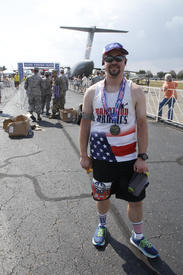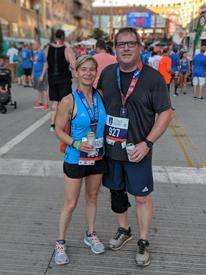Anaerobic HR Level

T1DCarnivoreRunner
Posts: 11,502 Member
This is a technical question for those who might know.
I've had fitness testing, including VO2 max. So I know RMR at VO2 Max, and where my anaerobic zone begins. I try to stay below that, of course, in order to avoid an oxygen deficit.
If HR is higher than it would normally be at the same exertion (specifically, due to high temperatures), does the anaerobic zone increase accordingly? Or am I just doomed to top out at a slower pace when it is hot out?
I've had fitness testing, including VO2 max. So I know RMR at VO2 Max, and where my anaerobic zone begins. I try to stay below that, of course, in order to avoid an oxygen deficit.
If HR is higher than it would normally be at the same exertion (specifically, due to high temperatures), does the anaerobic zone increase accordingly? Or am I just doomed to top out at a slower pace when it is hot out?
0
Replies
-
You will top out at a slower pace. Adjust accordingly, but don't worry too much. The appropriate stress & adaptation will still occur.2
-
You will top out at a slower pace. Adjust accordingly, but don't worry too much. The appropriate stress & adaptation will still occur.
Exactly. You will be amazed at the gains you will realize in the fall after exercising in the heat and humidity all summer long. But you definitely need to be conscious of hydration and electrolytes, which I am sure you already know.0 -
I think I knew that was the answer, but was hoping otherwise.

Thank you for the responses!0 -
If the increase in HR is due to cardiovascular drift, then your "normal" threshold HR will no longer apply and, yes, your "threshold" HR will likely be higher. The most reliable sign is your breathing. If HR increases without a corresponding increase in breathing, then your threshold number will be higher.
Here is actually a pretty good article on cardiovascular drift:
http://running.competitor.com/2014/05/training/the-effect-of-cardiac-drift-on-heart-rate-training_48317
Thermal stress is going to affect performance in a different way. In either case, one should not be overly dependent on HR data under these conditions.1 -
And to throw more in the mix, your lthr will vary based on activity. For example, mine is X for running and nordic skiing, but about X-5 for biking.0
-
If the increase in HR is due to cardiovascular drift, then your "normal" threshold HR will no longer apply and, yes, your "threshold" HR will likely be higher. The most reliable sign is your breathing. If HR increases without a corresponding increase in breathing, then your threshold number will be higher.
Here is actually a pretty good article on cardiovascular drift:
http://running.competitor.com/2014/05/training/the-effect-of-cardiac-drift-on-heart-rate-training_48317
Thermal stress is going to affect performance in a different way. In either case, one should not be overly dependent on HR data under these conditions.
This is very useful - from a further page http://running.competitor.com/2014/05/training/the-effect-of-cardiac-drift-on-heart-rate-training_48317/2Cardiovascular drift is mostly caused by the natural increase in core body temperature when running. This increase in core body temperature elevates heart rate the same way running in hot conditions does. Correspondingly, the stroke volume of the heart decreases so that cardiac output and oxygen uptake remain the same, keeping your breathing and effort similar while heart rate rises.0 -
midwesterner85 wrote: »If the increase in HR is due to cardiovascular drift, then your "normal" threshold HR will no longer apply and, yes, your "threshold" HR will likely be higher. The most reliable sign is your breathing. If HR increases without a corresponding increase in breathing, then your threshold number will be higher.
Here is actually a pretty good article on cardiovascular drift:
http://running.competitor.com/2014/05/training/the-effect-of-cardiac-drift-on-heart-rate-training_48317
Thermal stress is going to affect performance in a different way. In either case, one should not be overly dependent on HR data under these conditions.
This is very useful - from a further page http://running.competitor.com/2014/05/training/the-effect-of-cardiac-drift-on-heart-rate-training_48317/2Cardiovascular drift is mostly caused by the natural increase in core body temperature when running. This increase in core body temperature elevates heart rate the same way running in hot conditions does. Correspondingly, the stroke volume of the heart decreases so that cardiac output and oxygen uptake remain the same, keeping your breathing and effort similar while heart rate rises.
If you are interested, even that statement may be somewhat outdated. I unfortunately lost the link but an excellent study I read in the past year took a detailed look at cardiovascular drift and concluded that the increased heart rate was due primarily to...the increased heart rate. It seems that as exercise continues, the sustained rapid HR gradually starts to decrease stroke volume so the HR must "drift" upward to maintain cardiac output. Increased core temp and decreased plasma volume from dehydration also were factors, but they are minor ones.
0
This discussion has been closed.
Categories
- All Categories
- 1.4M Health, Wellness and Goals
- 397.1K Introduce Yourself
- 44.2K Getting Started
- 260.9K Health and Weight Loss
- 176.3K Food and Nutrition
- 47.6K Recipes
- 232.8K Fitness and Exercise
- 456 Sleep, Mindfulness and Overall Wellness
- 6.5K Goal: Maintaining Weight
- 8.7K Goal: Gaining Weight and Body Building
- 153.4K Motivation and Support
- 8.3K Challenges
- 1.3K Debate Club
- 96.5K Chit-Chat
- 2.6K Fun and Games
- 4.6K MyFitnessPal Information
- 16 News and Announcements
- 18 MyFitnessPal Academy
- 1.4K Feature Suggestions and Ideas
- 3.1K MyFitnessPal Tech Support Questions



